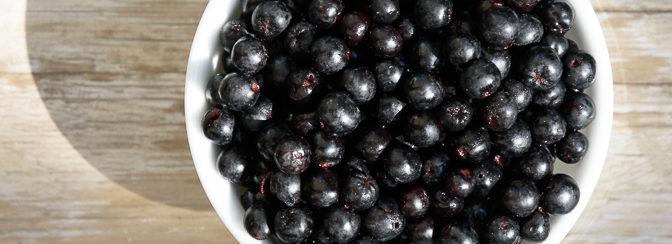Aronia Videos
Growing Aronia Berries
Find Aronia recipes in the recipes section
Aronia berries are from a perennial berry bush more closely related to apples and roses than other fruits it resembles in appearance. Aronia was, at first, recognized for its beauty as an ornamental. The green foliage in contrast to its white flowers is a lovely site in spring. Edible purplish black berries are high in antioxidants, vitamins, and phytonutrients which has brought it center state to consumer’s interested in healthy nutrient dense food and food as medicine.
Aronia berries, also called chokeberries, are bitter in flavor until they are ripe. Like a persimmon, the aronia berry will sweeten up after a freeze. Enthusiasts enjoy the aronia as a berry for juicing, baking, and in smoothies. You can incorporate them into any recipe that uses other berries and they will add complexity to the flavor of meat and vegetable dishes. They are particularly complimentary to salads.
Aronia berry bushes (Aronia melanocarpa) are native to North America, and they are suitable to plant in U.S. Department of Agriculture Hardiness Zones 3 to 8. The aronia plant was introduced to Russia and to Eastern Europe in the late 1800s where they gained popularity. There are thousands of acres of aronia growing in Europe today. Here in the U.S., aronia is growing in favor for its nutritional value.
Aronia has traveled overseas and back
Aronia Berries an Iowa Crop
The aronia berry bush is a hardy easy-to-grow plant. You can expect berries around the third year. Aronia is cold hardy to at least USDA Zone 3 (-40 degrees Fahrenheit).
Ideally, choose a sunny location for your aronia berry bushes. While a partially shady location will work too, you will enjoy a higher yield of berries in full sun. The plants grow well on various soil types from boggy soils that are poorly drained to well-drained sites. The optimum pH is slightly acid (6-6.5), but aronia will tolerate a wider pH range (5-8.5).
- Yield per plant (10-20 pounds).
- Yield per acre (5,000 – 10,000 pounds).
Late in its dormant season, prune some of the older branches of your bush down to the ground to promote a new growth. Harvest your aronia berries in early September or you can even wait until after a light freeze.
Aronia berry bushes are not prone to disease or to pests. Popular cultivars include ‘Viking’, a Russian cultivar that has recently been introduced back into the U.S. It is used commercially for its large, high-quality berries. It is a 6-8 foot tall bush that produces a large amount of berries. Also, Nero and Mackenzie are popular commercial fruit producing varieties. Whether your interest is in commercial production, ornamentals, or backyard edibles, Aronia berries are a versatile plant that has been rediscovered and represents the reshaping of the Midwest landscape and agriculture.

